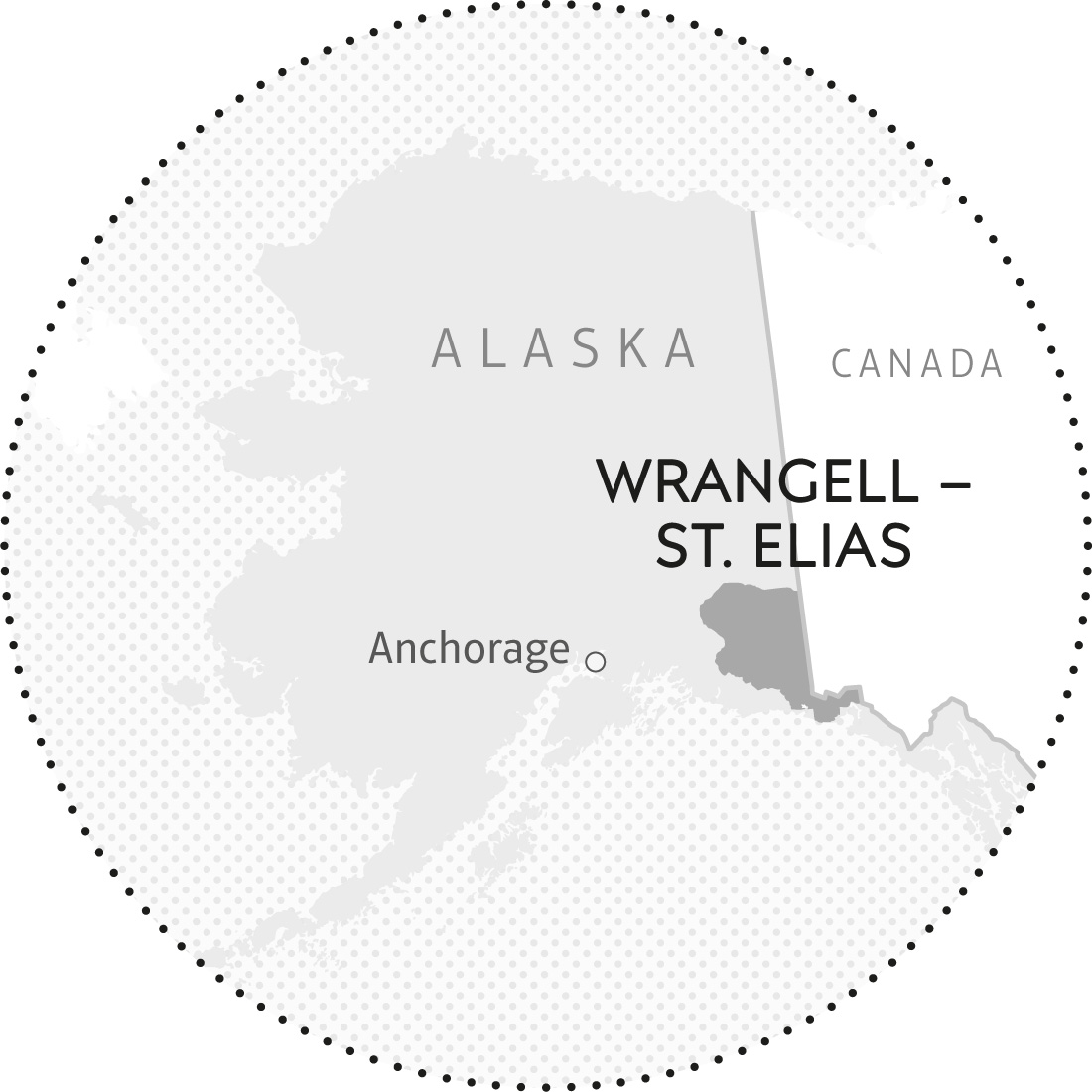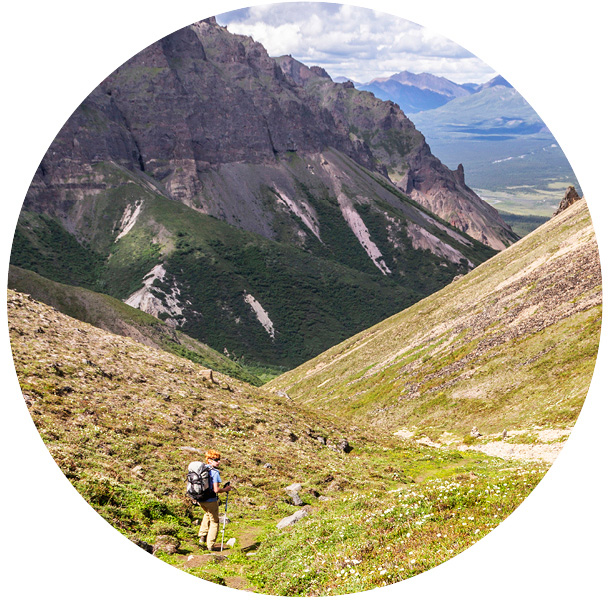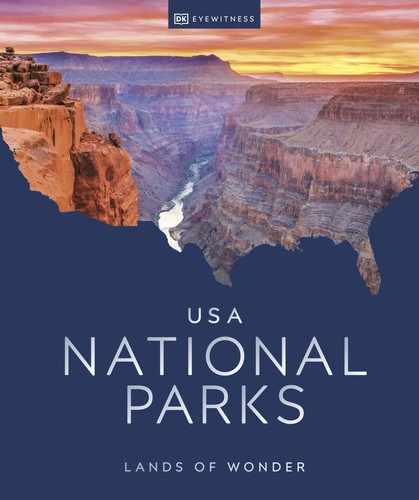
Alaska
WRANGELL–ST. ELIAS
ESTABLISHED 1980
Where the roads end and the snowcapped peaks scud to the sky, the wilds of Wrangell–St. Elias begin. Bigger than Yellowstone, Yosemite, and the state of Maryland combined, this is the nation’s largest national park.
There is nothing bigger, wilder, or more untamed on the planet. Sitting at the convergence of four mountain ranges—the Wrangells to the north, the Chugach to the southwest, the St. Elias mountains toward to coast, and the Alaska Range to the east—this huge national park encompasses a breathtaking variety of mountain and alpine landscapes. This is also the world’s largest international protected wilderness, which has been designated as a World Heritage Site, and combines Glacier Bay National Park and Preserve, and Canadian neighbors Kluane National Park Reserve and Tatshenshini-Alsek National Park.
The claims to fame don’t stop there. Here you will find some of the highest peaks in the United States, including the awe-inspiring Mount St. Elias. A few of the largest glaciers on Earth also flow through the park, such as the Nabesna Glacier, which is the longest nonpolar valley glacier in the world, stretching for 80 miles (129 km).
There’s even a volcano, too. Dominating the landscape at 14,163 ft (4,316 m), Mount Wrangell is one of the largest active volcanoes in the United States.
While the higher peaks of the park are buried beneath a perennial coat of snow and ice, there are spruce forests, mountain slopes covered by dwarf shrubs and grasses, and coastal areas where sea lions and harbor seals play in the arctic waters.

Ice-climbing on the Root Glacier is a breathtaking way to get up close to the formations
FOCUS ON
The First Ascent of Mount St. Elias
Climbing Mount St. Elias is not for the faint of heart or spirit. The first ascent of this 18,008-ft (5,488-m) peak was made by Luigi Amedeo di Savoia-Aosta, the Duke of Abruzzi. Using siege tactics, the Abruzzi expedition took several months to make it to the top. On July 31, 1897, they successfully summited.
Wilderness adventures
Thanks to its diverse topography, there are adventures big and small to be had in Wrangell–St. Elias National Park and Preserve. From the historic mining village of McCarthy, embark on epic glacier hikes or unwind with a fishing trip in nearby rivers. To the north, the Nabesna Road is a 42-mile (67-km) dirt route where you can camp and hike to remote crystalline lakes.
These road systems cover only a minuscule fraction of the park, and thrillseekers can engage in a bolder means of exploration. It all starts with a floatplane trip out to the middle of nowhere. From there, you can raft, backpack, or climb in some of Alaska’s most remote wilderness. If you’d rather not take on a big expedition, opt for a quick flight-seeing tour: the immensity of the park takes on whole new proportions from the air.
A day spent hiking around a glacier is an unbeatable experience. With crampons on your feet, an ice axe in your hand, and a guide who really knows their way around these dangerous ice environments, you’ll descend into magical ice caves, come face to face with vertical ice-climbing routes, or simply walk across these enigmatic natural features that have their own unique movement, sound, and energy.
Some of Alaska’s best rafting is found within the park, too. Whether you take on a four to eight-day expedition on the Copper, Tana, or Chitina rivers, or just keep it simple with a day trip out of McCarthy, rivers offer an easy way to explore deep into this wilderness and experience nature at her most pure.

Taking a floatplane to one of the park’s creeks is a thrilling start to a rafting trip
Best Day Hikes

Root Glacier Trail ▷ 8 miles (13 km) round trip. Marvel at the grandeur of the glowing blue-and-white edges of the Root Glacier on this classic hike from Kennecott.
Bonanza Trail 9 miles (14.5 km) round trip. It’s a steep one, with 3,800 ft (1,158 m) of vertical gain, but the reward is a spectacular view over the confluence of the Root and Kennecott glaciers. Have your camera at the ready.

Skookum Volcano Trail ▷ 2.5 miles (4 km) round trip. Accessed via the Nabesna Road in the north, this short trail along an eroded volcanic system leads to a high alpine pass where you’re guaranteed to spot Dall sheep.
A wealth of wildlife
The unspoiled lands in the park provide a sublime home for myriad species. On the ground, scan the lakes and willow bogs for moose, or if you’re up in the mountains there’s a good change of spotting Dall sheep. Look for black and brown bears in the fall, or smaller species, such as lynx, coyotes, and the lovable pikas and voles.
The Copper River valley offers the most awe-inspiring birding opportunities. Here you’ll sight migrating and nesting birds, including trumpeter swans, Canada geese, and rock ptarmigan. Expect to see species you’ve never seen before in the Lower 48, plus at least one or two bald eagles. Wherever you set up a watching station, Wrangell–St. Elias is a wildlife haven.
FOCUS ON
The First Guardians
The park is inhabited to this day by the descendants of its original settlers. The Ahtna and Upper Tanana Athabascans live in the interior of the park, while the Eyak and the Tlingit inhabit the coastal areas. Connecting with these Alaskan Natives and learning about their affinity with the land and unique way of life are an essential part of any journey into The Great Land.

The Wrangell Range is a dramatic contrast between snow-covered peaks and lush grasses
